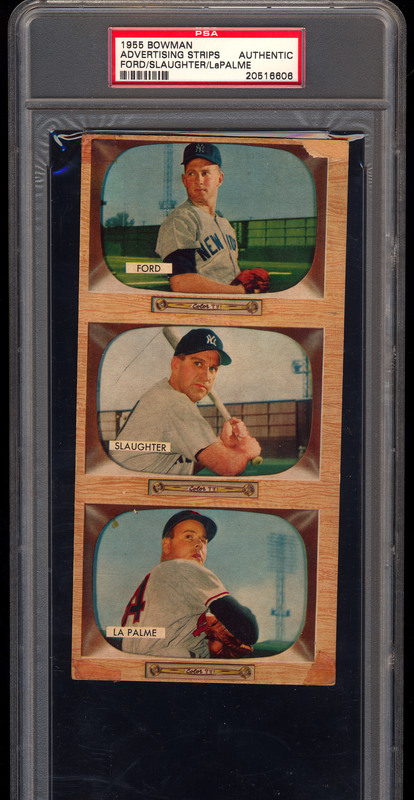In my opinion, in order to be a salesman sample, the material must contain ad copy. Any product without ad copy is just a product sample, but not intended to be used as a sales piece- that is just incidental. As you'll see below, all salesman samples contain copy directed at retailers, touting sales
The first usage of product as a collateral sales piece by Bowman was in 1954. Prior to that they used regular product with an accompanying letter.


They continued this practice in 1955


They didn't issue them in '53 or before, although 3 card panels are found on occasion. As these follow the common format (most, but not all, salesman samples issued by Topps and Bowman were 3 card panels) they are occasionally called salesman samples, but there is no evidence they were used as that and contain no ad copy. One dealer told me he thought they were salesman samples because the cards contained were in sequential order, but that is how '53 Bowman was printed, as evidenced by the full sheet below



Topps first issued salesman samples as a sales tool in 1952


Topps continued to issue baseball salesman samples thru 1967.
For the most part these were 3 card panels, but 4 card panels were created in 1956 to go along with a 3 card panel.
In 1960 Topps issued a 3 card panel along with a 8 card panel that contained salescopy on card stock. But this wasn't a regular sample with ad copy, it was blank backed and I would consider it a point of purchase (POP in the ad business) display. It announces the arrival of the new series of cards, but nothing about sales and was directed at the consumer, not the retailer.

A similar POP display was issued in '62.
In 1955 Topps issued a salesman sample with an attached '55 Doubleheader. They are often found with the Doubleheader removed, but all originally had them


A serious run up in prices on salesman samples occurred around '11-'15, as several collectors were trying to put a complete run of these together. Prices have dropped back down considerably, aided by a few finds flooding the market, most notably with '54 and '66 samples. During this time any 3 card panel was called a salesman sample in an attempt to realize a high price. I consigned a '49 Leaf boxing 3 card panel to an auction house as an uncut strip- they instead called it a salesman sample with no evidence as such and refused to correct the copy. '53 Bowman and other 3 card strips continue to be identified as salesman samples on ebay when they were in fact not ever used or issued as such.
Topps issued salesman samples for their football cards as well, I suspect (but do not have evidence of) those paralleled the years issued for baseball.
Fleer issued salesman samples for their '59 Ted Williams set, and a non sport set created that year (can't recall which one, Stooges maybe?) but I have never seen one for other years. '60 Fleer baseball 3 card strips are very common, and I've got a '63 Fleer 3 card strip (2 full sets of 3 card strips were offered by H&S a few years ago) but none of these, while having fully printed backs, have any ad copy; they are just regular uncut strips.
Here's a small image of each year (minus '53 which I don't own, but is similar to '52 and '54) of Topps salesman samples. As you can see Topps began with stickers over the product (as did Bowman both years) and got a lot more sophisticated on back printing later in the run.





